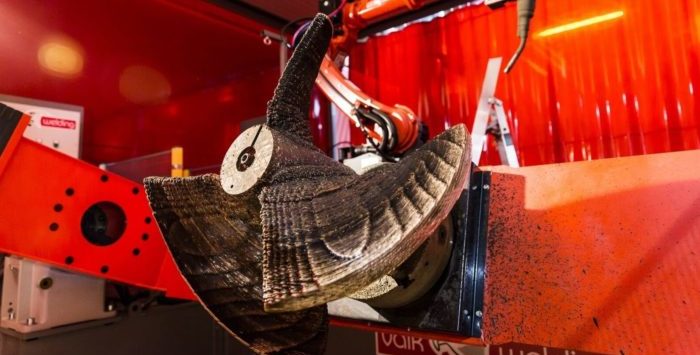As the issue of additive manufacturing or 3D printing is gaining ground in the marine industry, Braemar Managing Director – Asia, considers how 3D printing could be used both onshore and aboard to reduce delays relating to machinery breakdown.
What is 3D printing?
There are currently seven different additive manufacturing techniques referred to as 3D printing.
Material jetting is the most well-known manufacturing technique, where layers of plastic wire are melted on top of each other forming a 3D structure.
Powder-bed extrusion is the most interesting 3D printing technique for the marine industry, as this method can produce accurate and complex metal structures for spare parts.
What are the benefits?
Warehousing and shipping costs of spare parts for ships can be reduced by producing items on demand at any location. The parts can also be produced without the heavy scantlings previously created in the casting process and with efficient lightweight designs.
In a shipboard machinery breakdown scenario, delays can be reduced as replacement parts can be produced at the next port instead of being sent from the original equipment maker’s central warehouse. Small basic parts such as valves, pipe fittings or impellers could even potentially be made on board in the event of a failure.
Where are we now?
Engineers at Europe’s largest port – Rotterdam – are already exploring the use of additive manufacturing processes to quickly carry out repairs to damaged ships. The port has opened the Rotterdam Additive Manufacturing Lab (RAMLAB), an on-site facility that includes a pair of six-axis robotic arms, which is capable of additively manufacturing large metal industrial parts.
This enables RAMLAB to pursue faster fabrication options – 3D printing large ship components in metal and then finishing the pieces using traditional CNC milling and grinding methods within days. Recently, a tug propeller was made and successfully tested.
Additionally, this year, a Dutch crane manufacturer is reported to have printed a 3D offshore crane hook, which successfully passed its load test and all associated control checks.
Onboard production
Whilst the implementation of additive manufacturing on shore has a seemingly successful future, it is less likely that ship-borne 3D manufacturing will be as popular, especially for large components. A lot of components still require finishing by machine, thread-cutting or polishing, which are specialist skills.
Further, mechanical components used onboard are made from a wide variety of different alloys. To effectively implement shipborne 3D manufacturing, a similar range of materials would need to be kept on board, raising issues of degradation and space for storage in the correct controlled conditions.
Manufacturers and Class would still inevitably need to verify the quality of components, even if they are produced using OEM-approved programs and machines, as there is a risk that parts could be produced negligently.
The future
Despite these issues with onboard production, shoreside manufacturing is likely to be a reality soon, starting with Class-approved local workshops in strategic places to introduce this technology.
There are currently seven different additive manufacturing techniques referred to as 3D printing:
- Material jetting
- Powder-bed extrusion
- Material extrusion
- Binder jetting
- Directed energy deposition
- Vat photo-polymerisation
- Sheet lamination.
Above article was initially published at the September edition of Standard P&I Club’s Technology Bulletin and is reproduced here with the authors’ kind permission.
The views expressed in this article are solely those of the authors and do not necessarily represent those of SAFETY4SEA and are for information sharing and discussion purposes only.
About Graeme N Temple
 Graeme is a Marine Engineer and marine consultant specialising in superyacht technical investigations and surveys.His experience includes all types of H&M, P&I surveys and legal opinions an expert witness. He holds a Class 1 Chief engineer’s certificate and has twenty five years at sea of which fifteen years as chief engineer on towage/salvage vessels, small craft, general cargo, container and LPG.
Graeme is a Marine Engineer and marine consultant specialising in superyacht technical investigations and surveys.His experience includes all types of H&M, P&I surveys and legal opinions an expert witness. He holds a Class 1 Chief engineer’s certificate and has twenty five years at sea of which fifteen years as chief engineer on towage/salvage vessels, small craft, general cargo, container and LPG.


































































The article though brings out the necessity and probable methods of usability of the 3-D printing technology but using the technology onboard will demand additional space care and trained manpower. However if certain firms/ institutions are earmarked in every port which can manufacture the desired part on demand will have better advantage and savings to time effort and cost.